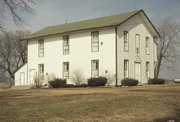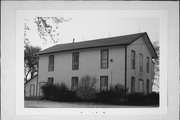| Additional Information: | A 'site file' exists for this property. It contains additional information such as correspondence, newspaper clippings, or historical information. It is a public record and may be viewed in person at the Wisconsin Historical Society, State Historic Preservation Office.
This simple vernacular building is the oldest Grange hall standing in Wisconsin and among the oldest remaining in the United States. It was also the seat of local government throughout much of its long history. Soon after local farmers organized the La Prairie Grange No. 79 in February 1873, the town donated land and $700 to build a meeting hall. In exchange, the town had the right to use the ground floor as a town hall. The Grangers built an unembellished two-story, front-gabled building with clapboard walls. Tall four-over-four windows are arranged symmetrically around a central double-door entry. Inside, the original vertical tongue-and-groove paneling sheaths the walls, interrupted only by a chair rail. A back stairway leads to the second-story hall where the Grangers met.
Oliver Hudson Kelley of Minnesota founded the Grange (officially the Patrons of Husbandry) in December 1867 to bring rural people together and teach them better farming techniques. Kelley patterned the group after fraternal organizations, complete with secret rituals, but unlike most fraternal lodges, the national Grange admitted women to membership and leadership on an equal basis with men. The Grange soon became increasingly political and increasingly popular, especially in the Midwest. Grangers lobbied hard against railroad monopolies, urged more efficient marketing of farm products, and called for the elimination of middlemen, who drove up transportation costs, reducing farmers’ profits. Grangers also demanded lower interest rates and, by the 1890s, free rural mail delivery and rural electrification.
Through it all, Grange halls provided social centers for farmers, hosting card parties, dances, suppers, and plays. At meetings, members discussed ways to improve dairying and farming and debated regional and national political issues of interest to farmers. The La Prairie Grange remains active to this day. In 1960, the town deeded its share of the building to the Grange, reserving the right to use it for town meetings and elections. |
|---|



